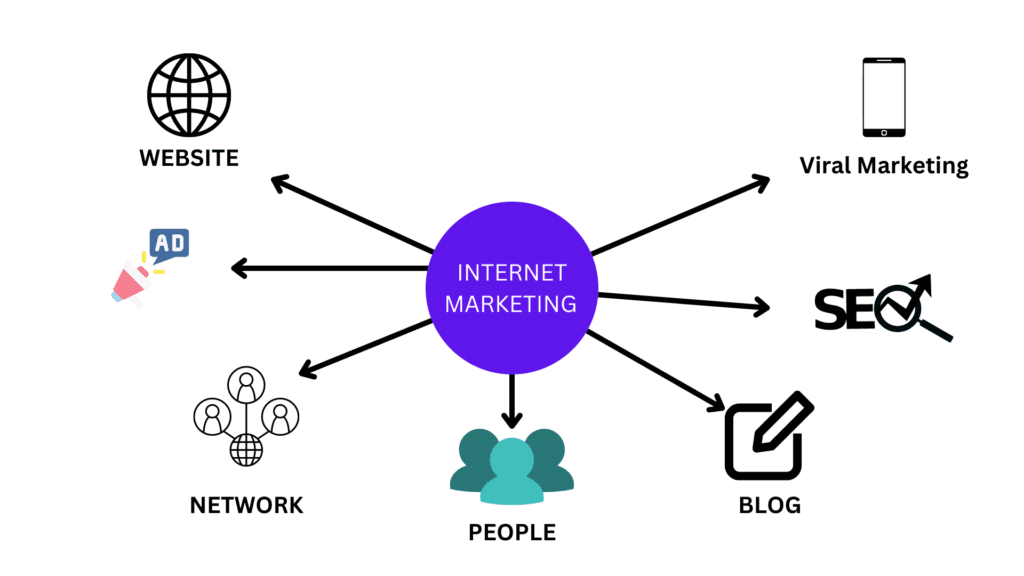Digital Marketing, Facebook Ads
Mastering the Art of Internet Marketing: Strategies for Success in the Digital Age
December 26, 2022
Mastering the Art of Internet Marketing: Strategies for Success in the Digital Age

Internet marketing is becoming increasingly important to businesses of all kinds in today's digital world as a means of expanding their brand recognition and communicating with their intended customers. Because of the proliferation of social media platforms, online shopping, and mobile devices, conventional marketing strategies are no longer sufficient to maintain a competitive advantage. Internet marketing, also known as online marketing or digital marketing, provides organizations with a wide variety of methods and approaches to engage with clients and promote their products and services online. Other names for internet marketing include online marketing and digital marketing. In this article, we will discuss the most important components of internet marketing, such as the different marketing approaches that are accessible, how to select the strategy that is best suited for your company, and how to evaluate the results of your efforts. Mastering the art of online marketing is vital for staying ahead of the competition and efficiently reaching your target audience, regardless of whether you own a tiny business or have years of marketing experience under your belt.
Understanding Internet Marketing

The term “internet marketing,” which is synonymous with “online marketing” and “digital marketing,” refers to the assortment of techniques and methods that are utilized to promote goods or services via the internet. Internet marketing’s goals are to link businesses with potential customers, raise consumers’ knowledge of the brands they sell, and eventually boost revenue and sales. Even if classic marketing techniques such as print advertising, radio and television ads, and billboards are still successful, in this day and age, using only these tactics is not enough to promote a business.
Internet marketing is distinct from more conventional forms of marketing in a number of important respects. To begin, it has a significantly broader scope of use. Because to the proliferation of the internet, companies may now communicate with customers all over the world, notwithstanding their actual locations. This has resulted in the creation of new opportunities and markets for companies of varying sizes. In addition, the internet enables businesses to specifically target customers based on demographic information, interests, and behavior, which makes the businesses’ marketing efforts more effective and efficient.
The degree of interaction between customers and sellers is another key aspect that differentiates internet marketing from more conventional forms of marketing. Internet marketing, on the other hand, enables firms to have a two-way discussion with their target audience, in contrast to more conventional marketing strategies, which are often limited to one-way communications. This can be done in a variety of techniques, such as commenting on blogs, engaging in social media, sending out email marketing campaigns, or participating in live chat assistance. This involvement contributes to the building of trust and relationships with customers, which can ultimately result in enhanced brand loyalty and advocacy.
The low cost of conducting business via the internet is among the most significant advantages offered by this kind of marketing. Conventional marketing strategies, such as television commercials and print advertisements, may be rather pricey and frequently call for a sizable spending budget in order to be successful. On the other hand, internet marketing enables firms to communicate with a far bigger number of people at a cost that is much lower. For instance, social media marketing can be done for free or at a little cost, and search engine optimization (SEO) can assist businesses in ranking better in search results and attracting organic visitors to their website. Both of these marketing strategies can be implemented.
Online marketing also enables better measurability and accountability than traditional marketing methods. When using more conventional techniques of marketing, it can be difficult to get an accurate reading on how successful a certain campaign has been. Yet, businesses can analyze a variety of metrics, such as website traffic, click-through rates, conversion rates, and engagement, to determine the efficacy of their efforts when using internet marketing. With this data, businesses are able to make data-driven decisions and real-time adjustments to their marketing strategy, which allows them to maximize the effectiveness of their marketing efforts.
In a nutshell, promoting one’s firm on the internet has evolved into an indispensable component of every business strategy. The capacity to reach a large audience, create engagement, operate at a low cost, and be measurable are some of the aspects that set it apart from more traditional ways of marketing. In order for businesses to build efficient marketing strategies that connect with their target audience and drive growth, it is essential for them to have a solid understanding of the main contrasts that exist between traditional marketing and online marketing.

Types of Internet Marketing : Diving into the World of Internet Marketing: Exploring the Various Strategies to Boost Your Online Presence
Significant changes have occurred in the marketing industry in recent years. Businesses now prioritize online advertising due to the proliferation of smartphones and other digital devices. Digital marketing is now fundamental to any successful advertising campaign. In this post, we’ll go through the several forms of online advertising and their relevance in the modern economy.
Search Engine Optimization (SEO)
SEO, or search engine optimization, is the practice of enhancing a website’s readability and relevance to search engine algorithms. Since Google controls 92% of the global search engine industry, SEO is vital for attracting free, organic website traffic. Search engine optimization (SEO) includes keyword study, on-page optimization, link-building, and technical SEO. It’s a plan for the long haul, so expect to put in lots of time and money.
PPC (Pay Per Click) Marketing
Paid per click (PPC) advertising is a style of online marketing in which companies pay only when their ad is clicked. Facebook Ads and Google Ads are the two paid advertising channels with the highest reported return on investment. PPC advertising is a quick and efficient way for businesses to reach their customers. The benefits are immediate, and it’s a great tool for increasing business.
Content marketing
Content marketing is the process of making and distributing useful information with the goal of gaining and keeping customers. Social media updates, videos, infographics, and blog pieces are all part of this. Brand recognition, authority in your field, and new leads may all be accomplished with the help of content marketing. Marketers in Databox have found that the most profitable forms of online promotion are content marketing and search engine optimization.
Social media marketing
Advertising on social media sites like Facebook, Twitter, Instagram, and LinkedIn is called “social media marketing.” Due to the fact that more than 4 billion individuals use social media every day, it is crucial to incorporate social media marketing into your overall plan. Using social media for marketing purposes allows companies to interact with their target market, forge new connections with them, and spread the word about their products and services.
Email marketing
Sending out mass emails is just one part of email marketing, which is a method of reaching out to potential customers. Advertising goods and services via email is a very efficient use of marketing resources. There is a strong return on investment (ROI) with a return of $36 for every $1 invested by enterprises. Email marketing is the most profitable marketing method for small firms, according to surveys.
Affiliate marketing
Companies use affiliate marketing, a sort of performance-based marketing, to reward its affiliates monetarily for driving traffic, sales, and conversions. By enlisting the help of other websites, or “affiliates,” a business can promote its goods and services to a wider audience. It’s an inexpensive strategy for increasing foot traffic and conversions.
In conclusion, a company’s marketing plan would be incomplete without online promotion. All of the aforementioned forms of internet marketing are essential for modern companies to build their brands, attract customers, and increase revenue. With these methods, companies can improve their marketing efforts and stay ahead of the competition.
Unlocking the Power of Digital Marketing: Finding the Best Strategy for Your Business

In today’s digital age, having an effective internet marketing strategy is essential for any business looking to thrive and remain competitive. With so many different channels and tactics available, it can be overwhelming to determine the best approach for your specific needs. Here, we’ll explore some key statistics to help you make informed decisions when it comes to your digital marketing strategy.
Search Advertising
Search advertising remains a popular and effective way to reach potential customers. In 2021, total search ad spend reached $144.8 billion, while digital ad spend worldwide is expected to hit $485 billion by 2023. When it comes to search ads, the average click-through rate across all industries is 18%, while the average cost per click is $3.53. Additionally, the average conversion rate across all industries is 82%.
Social Media Advertising
Social media has become a crucial element of many businesses’ digital marketing strategies, with 33% of all digital ad spending allocated to social media in 2022. Social media advertising has a higher click-through rate than display ads, with annual ad spend on social media reaching $134 billion in 2022. However, it’s important to note that paid search still generates more website traffic than paid social, with 15% of the average business’s website traffic coming from paid search and 5% from paid social.
Search Engine Optimization (SEO)
SEO is another crucial component of a successful internet marketing strategy. In 2019, the SEO industry was worth $43 billion, projected to reach $86 billion in 2023. Around 53% of all website traffic comes from organic searches, while businesses that blog generate 55% more traffic to their websites. Moreover, SEO leads have a close rate of nearly 15%, and 49% of businesses say that organic search brings them the best marketing ROI.
Social Media Marketing
Social media marketing is another popular channel, with businesses allocating an average of 14.9% of their marketing budget towards social media. More than 91% of businesses use social media for marketing, with Facebook being the most popular platform, followed by LinkedIn and Instagram. TikTok is the fastest-growing social media platform, with 40% of businesses planning to incorporate it into their 2022 social media strategy.
Setting Up Your Online Presence and Having an Internet Marketing Plan

Every company that wants to make it in today’s competitive market needs to have a strong internet presence. There are countless avenues open to businesses on the internet for communicating with and connecting with their target market, from social media to email marketing. Unfortunately, it is often difficult for firms to know where to begin because of the abundance of accessible options. That’s why it’s crucial to have a strategy for promoting your business online. Take a look at these shocking data about digital marketing to inform your approach.
Advertising on social media platforms: a game-changer for modern enterprises. There are more than 2 billion people on Facebook, and 90% of Instagram users follow at least one business, thus this medium offers great potential for brands to contact and interact with their intended consumers. Think about these things when you craft your social media marketing plan:
- The daily average time spent on social media by adults in the United States is over two hours.
- Ninety-one percent of consumers use their mobile phones to visit social networking sites.
- Influencer recommendations are trusted by nearly half of social media users when making a purchase.
- Brands who want to stand out from the crowd could take advantage of the fact that just about 5 percent of firms employ Facebook video marketing.
- Eighty-plus percent of B2B companies utilize Twitter for paid and organic social media marketing.
- There are 265 million people who use Snapchat every day, and together they launch the app more than 30 billion times a day.
- Those who use Snapchat are more inclined to make purchases directly from their phones. Moreover, 60% of their purchases are more likely to be made on the spur of the moment.
- According to a survey of American customers, LinkedIn is the most credible social media platform.
- When comparing the engagement rates of other social media platforms, TikTok comes out on top.
- 95% of Pinterest users have downloaded the app for usage in research or purchase.
Even though email marketing has been around for a while, it is still one of the best ways to connect and interact with your target audience. Statistics on email marketing are as follows:Current estimates place the value of the email marketing sector at $9.62 billion, but projections put that number at $17.9 billion by 2027.
- Up to 48 billion people throughout the world are expected to use email by 2024.
- Emails have an average open rate of 80% and a click-through rate of 2.78% across all sectors.
- Email marketing is the most profitable marketing medium for small firms, they say.
- Despite the low cost per click, 87% of firms utilize email marketing to disseminate their content.
- There will be a 2% annual increase, or 2 billion more emails exchanged per day, in the next three years.
Many consumers’ initial impressions of your company will come from your website. While crafting your online presence, keep the following statistics about website design in mind:
- Visitors to your website create an opinion about it in around half a second.
- The legitimacy of a business is evaluated by 75% of customers based just on the look of its website.
- The conversion rate on such websites can increase by as much as 400% just by providing a better user experience.
- Half of all consumers have a threshold of two seconds for the average page to load.
- Sixty-plus percent of respondents indicated they wouldn’t suggest a company with an unattractive mobile website.
- A call to action is lacking on the homepage of 70% of small company websites.
- Over 90% of customers who have a negative online shopping experience will go elsewhere
A solid online presence cannot be established without an internet marketing strategy. Reaching and interacting with your intended demographic is possible through the use of several online marketing strategies, including social media, email campaigns, and a well-designed website.
Create Compelling Content For Internet Marketing .

In today’s marketing world, content creation is more important than ever. Businesses that put resources into producing useful content are better able to attract new customers, retain existing ones, and increase sales. We dive into the findings of recent studies and reports to help you produce content that will resonate with your audience.
As a first step, remember that the vast majority of marketers are putting resources into content promotion. HubSpot reports that only 10% of marketers do not use content marketing, despite its proven effectiveness. There is no doubt that content marketing plays a significant role in the success of businesses today.
Having a well-documented content marketing strategy is essential for producing high-quality content. 40% of B2B marketers, and 64% of the most successful B2B marketers, have a documented content marketing strategy, according to the Content Marketing Institute. Developing content with a clear audience in mind and in line with business goals is much easier when a plan is in place.
Making content in a number of different forms is also crucial. HubSpot claims that by 2022, videos had surpassed the production of blogs and images as the most popular forms of content online. Nonetheless, it’s vital to remember that everyone has their own unique ways of taking in information. For instance, Wyzowl found that 73 percent of respondents preferred watching a short video about a product or service rather than reading text, while only 11 percent preferred reading text. In order to attract a larger customer base, businesses need to produce content that can be enjoyed by a variety of people.
The standard of your content is another consideration. According to HubSpot, the majority of marketers (83%) agree that posting less frequently in favor of higher-quality content is the way to go. This necessitates producing material that is both interesting and useful to the intended audience. The information and insights it provides should be unique and hard to find elsewhere.
To produce high-quality content, keyword research is also crucial. An overwhelming majority of business-to-business marketers (78%) use keyword research for search engine optimization before writing any content. This increases the content’s discoverability via search engines and thus its relevance to the intended audience.
Further, companies should put the informational requirements of their customers ahead of any sales or promotional messages. According to research conducted by the Content Marketing Institute, the vast majority (87%) of B2B marketers place an emphasis on meeting the educational requirements of their target demographic. As a result, it’s crucial that the information presented here be of high quality and contain unique insights. Additionally, it needs to solve problems experienced by the intended audience.
One last point: businesses need to measure how well their content marketing is performing. eMarketer found that the most effective marketers in North America track the results of their content marketing efforts. Businesses can learn about the effectiveness of their content by tracking metrics like engagement rates, lead generation, and conversion rates.
Latest Internet Marketing Techniques

Chat Bots
The advent of chatbots as a game-changing internet advertising medium has revolutionized the field of customer service. According to the data presented above, customers are increasingly turning to chatbots for instant, self-service help. Thanks to NLP and AI improvements, chatbots are becoming increasingly capable of providing engaging conversations that feel natural and tailored to the individual user.
It’s no secret that chatbots are becoming increasingly popular in businesses as a means to speed up responses, manage high volumes of customer inquiries, and boost overall customer satisfaction. Analyst firm Gartner estimates that using virtual customer service assistants can cut down on customer service-related phone calls, online chats, and emails by as much as 70%. As an added bonus, chatbots are available around the clock, allowing for quicker responses to customer inquiries and complaints.
Chatbots aren’t just for use in the service industry. Statistics show that businesses-to-business (B2B) websites make up 58% of all websites that use chatbot software. In addition, companies invested in conversational marketing tools as a means of addressing issues with Covid-19 customer service. Businesses can use chatbots for a wide variety of purposes, including lead generation, appointment scheduling, and product recommendation.
Because of the popularity of instant messaging and social media, chatbots have exploded in recent years. More than 5 billion people use messaging apps every month, providing a prime opportunity for businesses to meet their customers where they already spend much of their time. Over 260 million fresh conversations emerge each day in messaging apps like Facebook Messenger. Chatbots can help businesses enhance their marketing strategy, as the return on investment (ROI) from brand-customer conversations on Facebook Messenger is 30% higher than that of retargeting ads.
Using chatbots also allows companies to save money. The annual cost to businesses of responding to customer inquiries is over $1.3 trillion; chatbots have the potential to cut this cost in half. 30% of all chats can be handled by chatbots, allowing human agents to focus on the most complex cases. As a result, both agent efficiency and overall satisfaction with customers rise.
In conclusion, chatbots are a crucial tool for any online business’s marketing strategy. In addition to saving time and money, chatbots also offer personalized interactions with customers in a timely manner. Technology advancements have allowed chatbots to become increasingly lifelike and natural, leading to a superior customer service experience. With chatbots, businesses can boost their marketing efforts, cut down on support costs, and increase satisfaction among customers.
Newest Internet Marketing Technique : Augmented Reality

Over the past few years, augmented reality (AR) has seen consistent growth in both interest and investment. The value of the augmented reality market is projected to reach $10.5 billion in 2022, tripling its 2017 value of $3.5 billion. The market is expected to grow to a whopping $198 billion by 2025, so we’re only at the beginning.
The simplicity of incorporating augmented reality into existing workflows is a key factor in the technology’s rapid expansion. A survey of technology leaders in 2020 found that 57% agreed that incorporating AR into an existing app was much simpler than developing a high-quality VR app or content. As a result, the number of augmented reality (AR) gadgets has increased, with projections predicting that there will be 1.7 billion AR mobile gadgets in use across the globe by 2024.
Even India’s augmented reality market is expanding rapidly, with projections calling for a 38.9% compound annual growth rate from FY2027 onward. The increasing popularity of HMD products across a variety of industries has helped propel them to 35.84% of the market share in India.
However, working with AR/VR technologies does carry some legal risks, with 49% of respondents to a recent survey citing consumer privacy and data security concerns as a top risk. However, augmented reality’s usefulness in many fields cannot be ignored.
The global augmented reality gaming market is projected to reach $43.1 billion by 2028, expanding at a compound annual growth rate (CAGR) of 30.2%. The AR/VR market is projected to reach $10.82 billion by 2025, growing at a compound annual growth rate (CAGR) of 36.1%, with significant applications in the healthcare industry. There will also be a $6.72 billion market for business-to-consumer augmented reality ads by 2027.
Augmented reality is also becoming increasingly popular in the online retail sector. The worldwide market for AR/VR in education was valued at $12.4 billion in 2020, and it is anticipated to expand at a CAGR of 18.2% from 2022–2027. In 2020, consumer convenience products accounted for 52.9% of global spending on augmented and virtual reality technology.
Nevertheless, there are still obstacles to AR’s widespread adoption, despite the technology’s many advantages. 52 percent of retailers surveyed in the study said they didn’t feel ready to provide support for artificial intelligence (AI), chatbots, and augmented reality (AR).
57% of creative thinkers believe that navigation is the most promising application for future AR/VR technologies. In contrast, urban construction and infrastructure planning are seen as top-tier applications by 44% of innovators.
Also anticipated to expand rapidly is the global augmented reality (AR) market in the automotive sector, which is forecast to increase from $4.51 billion in 2021 to $14.44 billion in 2028, a compound annual growth rate (CAGR) of 18.1%. Micro LED display chips for augmented reality smart glasses are expected to generate $41 million worldwide by 2026.
Post tag :
Digital Marketing, Facebook Ads

DAMITH M DISANAYAKA
Digital Marketing Specialist
elymant.com
Categories
Recent Post
Subscribe
Follow Us

